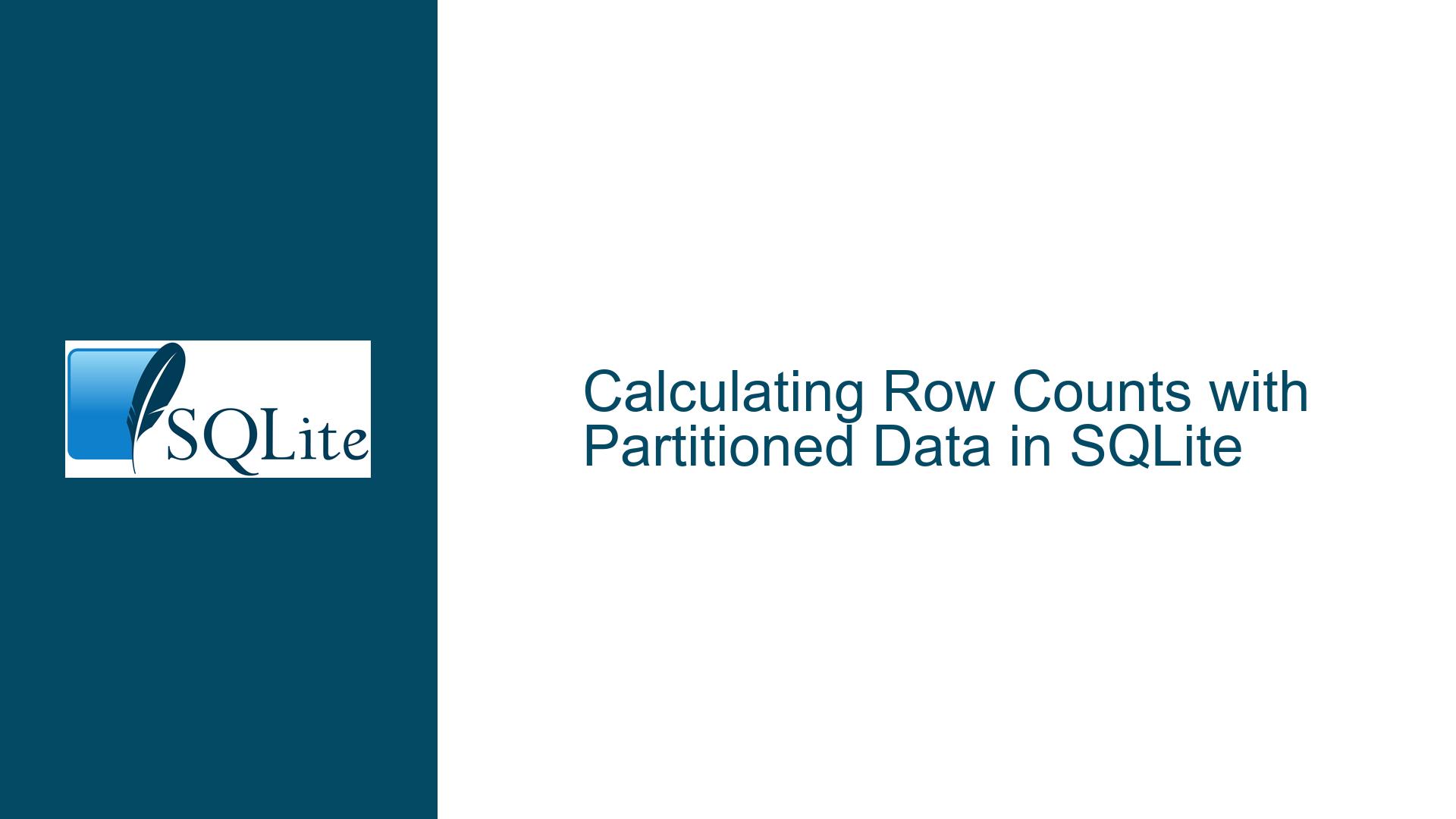Calculating Row Counts with Partitioned Data in SQLite
Generating Sequential Row Counts Within Data Partitions
The core issue revolves around generating sequential row counts within partitions of data in an SQLite database. Specifically, the goal is to produce a result set where each row contains an index (IDX), a data value (DATA), and a count that represents the row’s position within its data partition, along with the total number of rows in that partition. For example, given the following data:
| IDX | DATA |
|---|---|
| 1 | a |
| 2 | a |
| 3 | a |
| 4 | b |
| 5 | b |
| 6 | b |
| 7 | b |
| 8 | b |
| 9 | c |
| 10 | c |
The desired output is:
| IDX | DATA | COUNT |
|---|---|---|
| 1 | a | 1 / 3 |
| 2 | a | 2 / 3 |
| 3 | a | 3 / 3 |
| 4 | b | 1 / 5 |
| 5 | b | 2 / 5 |
| 6 | b | 3 / 5 |
| 7 | b | 4 / 5 |
| 8 | b | 5 / 5 |
| 9 | c | 1 / 2 |
| 10 | c | 2 / 2 |
This requires calculating two values for each row: its position within the partition of rows sharing the same DATA value, and the total number of rows in that partition. The challenge lies in efficiently computing these values using SQLite’s capabilities, particularly when dealing with larger datasets or more complex partitioning criteria.
Challenges with Window Functions and Partitioned Aggregates
The primary challenge in achieving the desired result stems from the need to perform two distinct but related calculations within the same query: generating a sequential row number within each partition and counting the total number of rows in each partition. SQLite’s support for window functions, introduced in version 3.25.0, provides a powerful toolset for such tasks, but their usage requires careful consideration to avoid performance pitfalls and ensure correctness.
One common mistake is attempting to calculate the row number and partition count in separate subqueries, which can lead to inefficiencies due to redundant scans of the data. Another potential issue arises when the data contains non-contiguous partitions, as the query must correctly handle cases where rows with the same DATA value are not adjacent. For example, consider the following extended dataset:
| IDX | DATA |
|---|---|
| 1 | a |
| 2 | a |
| 3 | a |
| 4 | b |
| 5 | b |
| 6 | b |
| 7 | b |
| 8 | b |
| 9 | c |
| 10 | c |
| 11 | a |
| 12 | b |
| 13 | c |
In this case, the desired output should reflect the overall position of each row within its partition, rather than restarting the count for non-contiguous segments:
| IDX | DATA | COUNT |
|---|---|---|
| 1 | a | 1 / 4 |
| 2 | a | 2 / 4 |
| 3 | a | 3 / 4 |
| 4 | b | 1 / 6 |
| 5 | b | 2 / 6 |
| 6 | b | 3 / 6 |
| 7 | b | 4 / 6 |
| 8 | b | 5 / 6 |
| 9 | c | 1 / 3 |
| 10 | c | 2 / 3 |
| 11 | a | 4 / 4 |
| 12 | b | 6 / 6 |
| 13 | c | 3 / 3 |
Achieving this requires a clear understanding of how window functions operate and how to structure the query to avoid misinterpretations of the partitioning logic.
Leveraging Window Functions for Partitioned Row Counts
To solve the problem, we can use SQLite’s window functions, specifically ROW_NUMBER() and COUNT(), combined with the PARTITION BY clause. The ROW_NUMBER() function assigns a unique sequential integer to each row within its partition, while the COUNT() function calculates the total number of rows in each partition. By using these functions together, we can generate the desired output in a single query.
Here is the SQL query that accomplishes this:
SELECT
idx,
data,
ROW_NUMBER() OVER (PARTITION BY data ORDER BY idx) || ' / ' || COUNT(*) OVER (PARTITION BY data) AS count
FROM
tmp
ORDER BY
idx;
This query works as follows:
Partitioning the Data: The
PARTITION BY dataclause divides the rows into groups based on theDATAcolumn. Each group contains all rows with the sameDATAvalue.Generating Row Numbers: The
ROW_NUMBER() OVER (PARTITION BY data ORDER BY idx)function assigns a sequential number to each row within its partition, ordered by theIDXcolumn. This ensures that the row numbers are correctly ordered within each group.Counting Rows in Partitions: The
COUNT(*) OVER (PARTITION BY data)function calculates the total number of rows in each partition. This value is the same for all rows within the same partition.Concatenating Results: The
||operator concatenates the row number and the total count into a single string, formatted as "row_number / total_count".Ordering the Output: The
ORDER BY idxclause ensures that the final result set is ordered by theIDXcolumn, maintaining the original row order.
This approach is efficient because it performs both calculations in a single pass over the data, leveraging SQLite’s window function capabilities to avoid redundant scans. It also handles non-contiguous partitions correctly, as the ROW_NUMBER() and COUNT() functions operate over the entire partition, regardless of the physical order of the rows.
Example Output
For the extended dataset mentioned earlier, the query produces the following result:
| IDX | DATA | COUNT |
|---|---|---|
| 1 | a | 1 / 4 |
| 2 | a | 2 / 4 |
| 3 | a | 3 / 4 |
| 4 | b | 1 / 6 |
| 5 | b | 2 / 6 |
| 6 | b | 3 / 6 |
| 7 | b | 4 / 6 |
| 8 | b | 5 / 6 |
| 9 | c | 1 / 3 |
| 10 | c | 2 / 3 |
| 11 | a | 4 / 4 |
| 12 | b | 6 / 6 |
| 13 | c | 3 / 3 |
This output meets the requirements, providing both the sequential row number within each partition and the total count of rows in the partition, formatted as specified.
Performance Considerations
While the query is efficient for moderate-sized datasets, performance may degrade with very large tables or complex partitioning criteria. In such cases, consider the following optimizations:
Indexing: Ensure that the
DATAandIDXcolumns are indexed, as this can significantly speed up the partitioning and ordering operations.Materialized Views: For static or infrequently updated data, consider using a materialized view to store the precomputed results, reducing the need for repeated calculations.
Query Simplification: If the dataset is large and the partitioning criteria are complex, breaking the query into smaller, more manageable parts may improve performance.
By understanding the nuances of SQLite’s window functions and applying these techniques, you can efficiently generate partitioned row counts and handle even the most challenging datasets.






